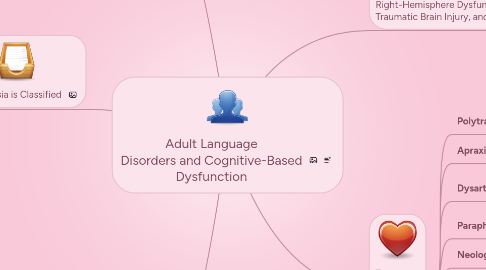
1. Right-Hemisphere Dysfunction, Traumatic Brain Injury, and Dementia
1.1. Right Hemisphere Dysfunction
1.1.1. Results from neurological damage to right cerebral hemisphere of the brain
1.1.2. Leads to:
1.1.2.1. Lack of awareness of problems
1.1.2.2. Lack of awareness of complete left side of body
1.1.2.3. Difficulty recognizing faces
1.1.2.4. Compromised pragmatics
1.1.2.5. Wordy expressions
1.1.2.6. Dysarthria or dysphagia
1.2. Traumatic Brain Injury
1.2.1. Neurological damage of brain from impact of external forces (Head injury)
1.3. Dementia
1.3.1. Chronic and progressive decline in memory, cognition, language and personality due to dysfunction of central nervous system.
2. Terms
2.1. Polytrauma
2.1.1. Traumatic brain injury from the use of improvised explosive devices (Mainly military)
2.2. Apraxia
2.2.1. Difficulty planning and executing movements of speech
2.3. Dysarthria
2.3.1. Disruption of range, speed, direction, timing, and strength of movements in the respiratory, phonatory, articulatory, or resonatory components of speech.
2.4. Paraphasias
2.4.1. Types of word production errors seen in a person with aphasia.
2.5. Neologisms
2.5.1. Use of made up words
2.6. Thombosis
2.6.1. Stationary ischemic blockage which occurs when plaque builds up in an artery and closes off.
2.7. Jargon
2.7.1. Use of real words put together without any meaning
2.8. Prosody
2.8.1. Melody, intonation, and rhythm of speech
2.9. Logorrhea
2.9.1. Appearing verbose or talking excessively.
3. What is Aphasia?
3.1. Definition:
3.2. A language disorder that is acquired sometime after and individual has developed language competence.
3.3. Types of Aphasia:
3.4. Broca's Aphasia
3.5. Transcortical Motor Aphasia
3.6. Transcortical Sensory Aphasia
3.7. Wernicke's Aphasia
3.8. Global Aphasia
3.9. Anomic Aphasia
4. How Aphasia is Classified
4.1. <---Problem: Agrammatism
4.1.1. Broca's Aphasia
4.1.2. Transcortical Motor Aphasia
4.2. <---Problem: Word-finding (Anomia)
4.2.1. Any type of aphasia is possible
4.3. <---Problem: Telegraphic Speech
4.3.1. Broca's aphasia
4.3.2. Transcortical Motor Aphasia
4.4. <---Problem: Paraphasias
4.4.1. Transcortical motor aphasia
4.4.2. Wernicke's Aphasia
4.4.3. Transcortical Sensory Aphasia
4.5. <---Problem: Jargon
4.5.1. Wernicke's aphasia
4.6. <---Problem: Neologisms
4.6.1. Wernicke's Aphasia
4.7. <---Problem: Effortful articulation
4.7.1. Broca's Aphasia
4.7.2. Global Aphasia
4.8. <---Problem: Initiation Difficulties (Adynamia)
4.8.1. Transcortical motor aphasia
4.8.2. Global Aphasia
4.9. <---Problem: Comprehension deficites
4.9.1. Wernicke's Aphasia
4.9.2. Transcortical Aphasia
4.10. <---Problem: Impaired repetition
4.10.1. Global Aphasia
4.10.2. Wernicke's Aphasia
4.10.3. Conduction Aphasia
5. How Aphasia is Identified and Treated
5.1. It is the Speech-Language Pathologist's job to be able to identify what output the patient is struggling to provide (i.e. understanding long-term phrases or following directions).
5.2. Questions to Answer:
5.2.1. Is aphasia present?
5.2.2. If so, what type or syndrome of aphasia is indicated by symptoms and the site of injury?
5.2.3. What treatment plan will be most beneficial?
5.2.4. What is the prognosis for recovery?
5.2.5. Are any referrals to other professionals needed?
5.3. Screening
5.3.1. Examination of patient based on speaking, listening, reading, and writing skills to determine if aphasia is present.
5.4. Treatment
5.4.1. Treatment of aphasia varies based on its type and intensity. But in example, for a patient with bad naming abilities, a Speech-Pathologist might seek to improve the underlying process that is impaired.
5.4.2. Creating treatments require "Evidence-Based Practice", which involves giving consideration to interventions that have been studied in a controlled matter and offer improvement.
5.4.3. Must also take into account culturally and linguistically diverse clients
